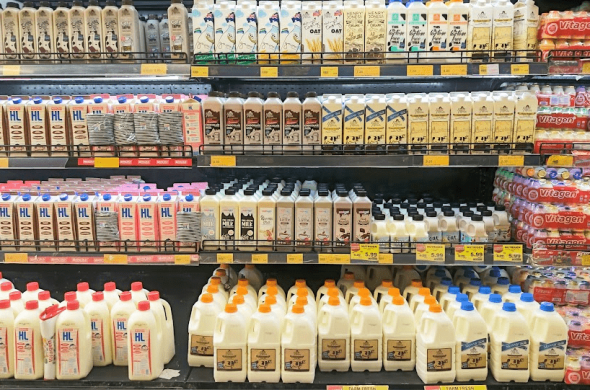Whether you work in processed foods, distribution, or supplements and additives, keeping abreast of industry trends is essential for strategy and growth. It’s important to understand how various trends are being used, and how consumers are reacting to them.
All food and beverage industry players should be informed of emerging movements, and consider which ones to incorporate into their own business while keeping the consumer in mind.
As experts in food and beverage consulting, we’ve rounded up 22 trends to keep on your radar.
1.Branded Meal Kits
Branded meal kits have become an unstoppable phenomenon around the world, largely supported by the e-commerce culture and the motive to reduce the amount of food wastage. Consumers can order meal kits with the exact amount of ingredients for a serving, and the recipe to combine them.
Not only do the meals provide convenience, but they also offer businesses an opportunity to brand their meals. The hassle-free cooking solution has been dubbed the biggest trend of 2021, even in cities like Dubai which thrives off of foodies who enjoy dining out.
2.Plant-Based Foods
As consumers educate themselves on the benefits of plant-based foods, such as improved health and sustainability, brands are responding. The accelerated demand for plant proteins and alternatives to animal products has led to a disruption in the industry.
For example, a recent survey revealed that 45 percent of UAE diners replaced dairy with a plant-based meal over the past year. In response, businesses are making an effort to label plant-based foods and produce alternatives for meat and dairy products.
3.Eco-Friendly Restaurants
Restaurants have had to adapt during the pandemic, fast-tracking emerging trends such as the focus on sustainability. There has been a rising focus on eco-friendly packaging, reducing energy usage, restructuring food shipments, minimizing food waste, and even using eco-friendly cleaning products.
Consider Bareburger, one of the restaurants in Dubai that are leading the charge. The restaurant’s floors, ceilings, and furniture are all made from sustainable or recycled materials, all ingredients are free-range and sourced from local farms. Even the packaging is compostable or made from recycled materials.
4.Streamlined Menus
Psychologists have released a study revealing that too many options can lead to customers purchasing nothing at all. Gone are the days of restaurants offering long, extensive menus that contribute to complex training, inefficiency, and food waste. Shortening the options to a streamlined menu has introduced several benefits.
Some of the key benefits from streamlined menus include boosting the bottom line, simplifying online orders, improving the customer experience, and reduced labor costs.
5.Immune-Boosting Foods
Covid-19 has triggered anxiety and concern about overall health. As a result, there’s been an increase in superfoods that are rich in immune-boosting ingredients. Brands that recognize the trend have started including these ingredients into their products.
Not only are brands creating immune-centric products, such as Dubai’s Little Erth by Nabz & G’s cleansing juices, but there will also be increased interest in the research of immune-boosting ingredients and the role of the microbiome.
6.Nutrition Information QR Codes
Consumers are becoming increasingly conscious of their consumption habits. Brands are choosing to engage with their consumers in different ways, giving them the power to make informed choices. As a result, nutrition information QR codes are becoming a trend.
Consumers have demonstrated an interest in nutritional awareness, sustainability, and social responsibility. Providing a nutrition information QR code is an effective way to offer clarity. Prioritizing transparency is a demand impacting all areas of the food and beverage industry. For example, mandatory biotech labeling law has impacted the Agtech trends that are shaping the future.
7.Comfort Foods
Along with the increased focus on health and eco-consciousness, there’s also a demand for comfort foods. Aligned with a sense of nostalgia, comfort food offers emotional benefits, such as an improved mood during a challenging time.
Brands continue to provide comfort foods but should be aware of the negative impact on physical health. Some brands are adapting the recipe of comfort food to reduce any unhealthy effects. For example, incorporating nostalgic flavors into healthier food items, and creating DIY-comfort kits with healthier ingredients.
8.Fine Dining Post-Covid
When restaurants were shut down during the pandemic in 2020, consumers were forced to cook at home and give up their culinary indulgences at fine dining restaurants. However, as restrictions have been lifted, fine dining is back on the cards.
Restaurants and the rest of the hospitality industry are opening up again with a few developments. People have saved their pennies during the pandemic and have developed a newfound appreciation for eating out again.
9.Online Table Bookings
Restaurants are opening up around the world. To keep their patrons safe during the pandemic, they are leveraging technology. In addition to implementing social distancing rules, they are also using QR codes for menus and using online table booking methods.
To counter the threat of no-shows, which account on average between 5-20% of total restaurant bookings, restaurants are asking for a deposit with each booking. Others are charging a penalty for dropouts by crediting the booker’s card.
10.Contactless Ordering and Curbside Pickup
To prevent the spread of the Covid-19 virus during the peak of the pandemic, restaurants adopted a contactless ordering and delivery service. The idea was a major hit and continues to be a popular option for safe delivery methods.
With the contactless ordering and delivery methods, customers have the option of leaving instructions on where they want their order to be placed. Customers can also select prepayment and pre-tipping to minimize contact. Not only do many food delivery services prefer this method of delivery, but a significant percentage of customers do as well.
11.Low-Waste Meals
Low-waste meals are gaining popularity as more consumers are looking for ways to reduce their carbon footprint. Various efforts are being made to reduce waste, such as the Abu Dhabi’s Environment Agency’s plan to be free of single-use plastic bags by the end of 2021. Eco-friendly packaging is a key criterion for low-waste meals, giving consumers the confidence to eat takeaway without the guilt of extensive waste.
Other criteria involve reducing the amount of food leftover. As a whole, the UAE is embracing innovative ways for sustainable food production and better management of food waste.
12.Meal Subscriptions
Meal kit subscriptions boomed during the pandemic, delivering regular, pre-portioned meals to customers all around the world. The meal kit industry is expected to continue as a trend, as the demand for healthy and convenient meals at affordable prices remains.
Moving forward, customers will be selecting their subscriptions based on a commitment to sustainability, diet specialization, organic foods, competitive prices, and extended delivery services.
13.Gourmet Food Halls
The trend of the gourmet food hall has been growing over recent years. It revolutionizes the concept of a traditional food hall to include upscale chefs, communal dining, and gourmet cuisine. Chefs and consumers alike love food halls, offering a win-win experience for both parties.
Gourmet food halls provide opportunities for chefs and entrepreneurs to showcase their products in a highly competitive environment. Consider the popularity of the Time Out Market which is hosted at the food hall at Souk Al Bahar, where top eateries gather to produce a world-class, gourmet experience.
14.Vegan Cuisines
In addition to plant-based foods, there is a heightened awareness (and adoption) of vegan lifestyles around the world. Consider how there has been a steep increase in vegan supermarket options across the MENA region as communities rediscover their vegan heritage.
The rising interest in veganism has inspired the production of vegan products in the supermarket and the availability of vegan options at restaurants. In turn, the availability has inspired an increase in veganism (and the cycle continues).
15.Marketing Automation and Loyalty Programs
Customer loyalty is a building block for long-term success. The food and beverage industry has adopted specific ways to boost customer satisfaction and loyalty.
One of the ways is marketing automation. Marketing automation allows businesses to become more efficient and better engage with customers. Examples include QR codes, social media engagement, and subscriptions.
Another method involves loyalty programs, offering a simple reward for continued business. Loyalty programs benefit consumers by saving them money, and benefits businesses by earning them repeat customers.
16.Community Centricity
The pandemic has placed a large emphasis on social distancing and reducing unnecessary contact. Even so, there is a need for community, and businesses in the food and beverage industry to focus on community centricity. At the core of community centricity are aspects of connections and engagement.
Community centricity can manifest in different ways. For example, businesses can get involved in food security projects in their local community, increasing their social responsibility. Another example is requesting customer feedback and putting customers’ needs at the heart of their innovation.
17.Healthy and Diet-Specific Foods
A recent Food & Health survey revealed that one of the most common reasons for following a diet in 2021 is to protect long-term health. Consumers are paying more attention to nutritional details and making an effort to include diet-specific foods in their meal plans.
Brands are responding by producing healthier alternatives to previously unhealthy options. For example, House of Pops, a Dubai-based ice cream shop, noted a need for keto ice cream.
18.Pop-Up Restaurants
Pop-up restaurants are a newer trend that has fluctuated in success over the years. For the upcoming season, it seems as though pop-up restaurants will be a popular alternative to traditional dining.
There are several benefits of pop-up restaurants that attract restaurateurs, including mobility, saving costs, attracting investors, and testing new ideas. They are especially successful as a catering solution.
19.Cloud Kitchens
Opening up a restaurant is a big investment, especially in foodie cities like Dubai where competition is intense. Cloud kitchens, also known as ghost kitchens, serve as delivery-only spots that can cut the costs of startups while providing them space to start their business.
Once again, technology is used to receive orders and make the model successful. The meal is prepared at a centralized, licensed venue, then it is delivered to the correct address. The increased demand for food delivery and enhanced enthusiasm of restaurateurs has led to the growth of cloud kitchens, especially in the UAE. An example is Kitopi, one of the world’s leading cloud-based kitchen platform which recently became a unicorn after raising $415 mln funding from different investors including SoftBank Vision Fund 2.
20.Digital Signage and Interactive Menus
There has been an increased demand for digital signage and interactive visual displays in restaurants. Brands are using the opportunity to create innovative and alluring signage to attract potential customers through visual prompts.
Digital screens are used to showcase the menu, saving money on paper and improving customer experience. Venues broadcast a rotating selection of social media feeds, menu items, daily specials, and more.
21.Kitchen Automation
Automation tools have been prioritized in the kitchen as a way to improve efficiency and increase productivity. In addition, kitchen automation offers an opportunity to improve food safety.
Several kitchens have introduced robotic tools, such as Sally the salad-making robot and Picnic, the automatic pizza maker. These tools help to save time on mundane tasks, opening up the capacity for chefs to focus on more engaging tasks in the kitchen.
22.Digital Kitchen Orders
Digital kitchen orders are another way that the food and beverage industry is streamlining the production process. By leveraging technology, restaurants allow consumers to order ahead and organize third-party delivery.
Digital kitchen orders also allow restaurants that use digital menus to improve the ordering process. As an added bonus, it helps restaurants save money on stationery.
It’s essential that effective strategy, design, and execution are built on a strong foundation of relevant insights. The food and beverage industry, in particular, is constantly evolving and developing new trends.
Food & Beverage Consultancy Services
Expert food and beverage consulting services, offered by Ollen Group, are key in staying ahead of the competition and optimizing productivity.
Read our latest insights, ideas, and perspectives that explore the trends shaping the future of business and society, including the Food & Beverage industry. Our consultancy services go hand-in-hand with these insights, confirming our position as industry leaders. Get in touch to find out more about our food and beverage consulting services and industry expertise.



